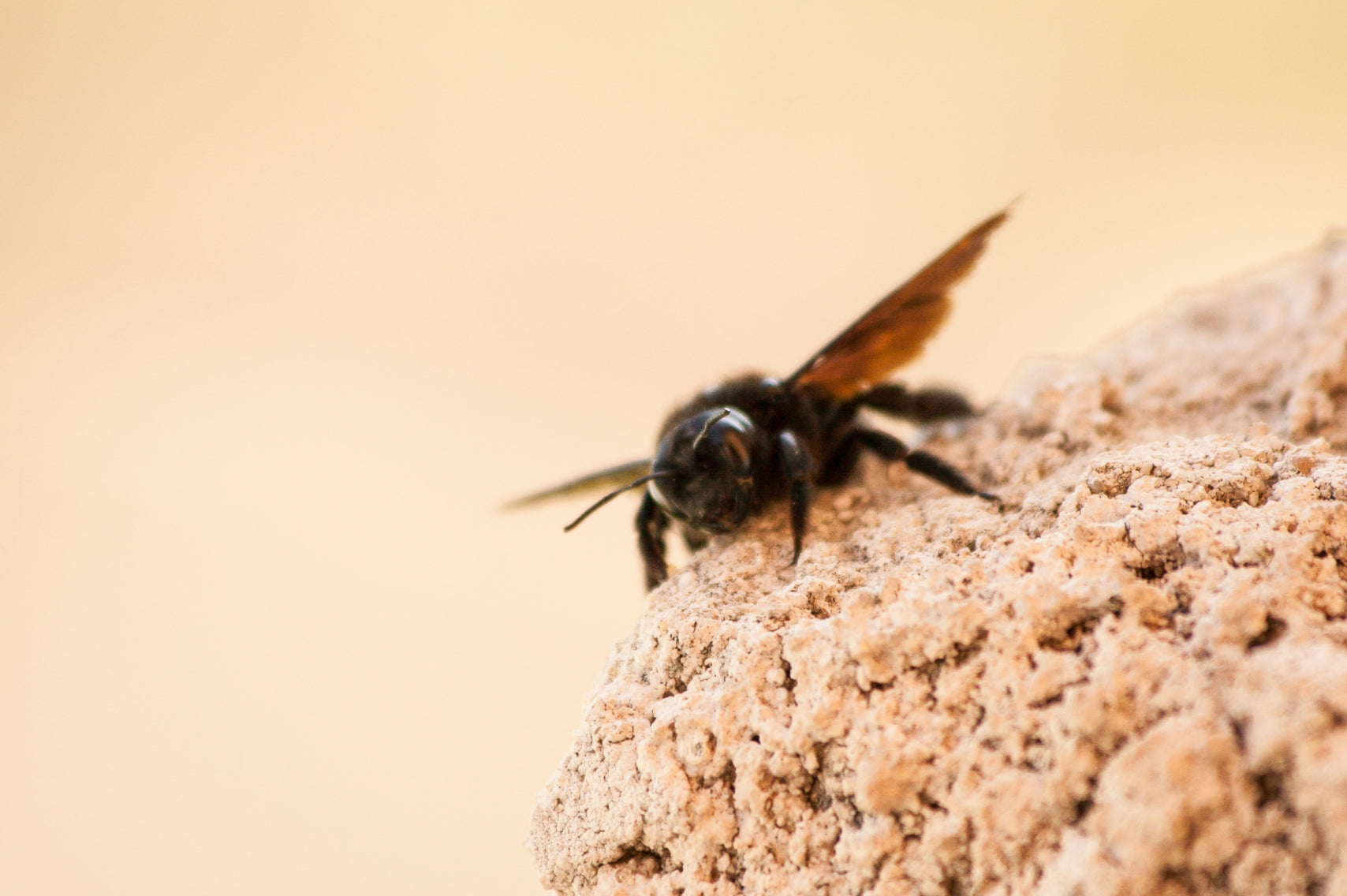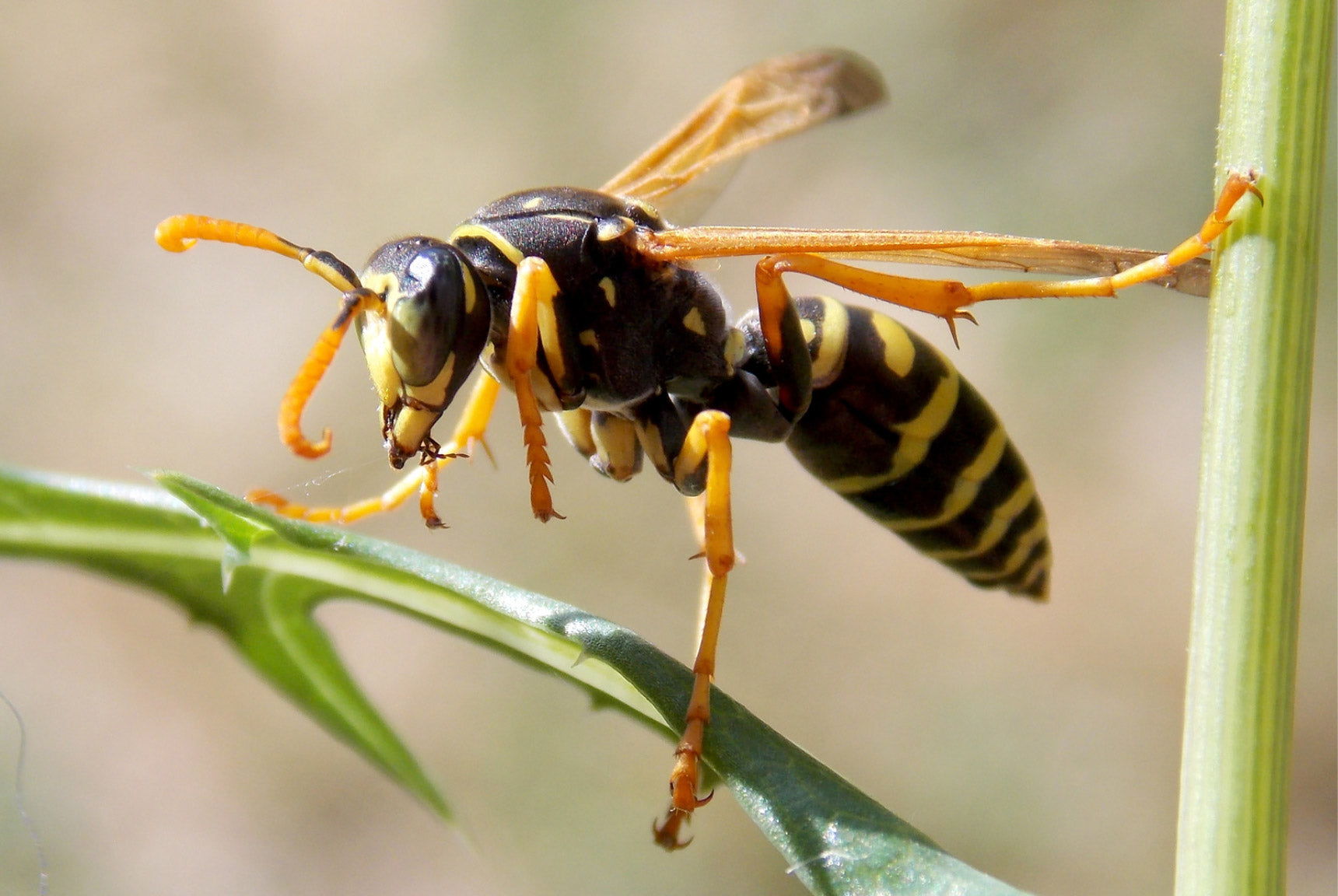After we’ve survived yet another cold and interminably long winter, the first thing many of us look forward to at the onset of balmier spring and summer weather is the opportunity to make use of our outdoor spaces. Decks, porches, the backyard – and, of course, the mouthwatering sizzle of a freshly cooked meal on the grill – all symbolize the seasonal change. But if there’s one thing that can ruin a weekend faster than an impending deadline hovering over your head, it’s the all-too-real sensation of a creature hovering over you! Specifically, we’re talking about the ever-industrious excavators known as carpenter bees.

Despite their relatively small size, what these little bees lack in muscle, they more than make up for in sheer bravado. Uninvited though they may be, carpenter bees are determined protectors of “their” territory, and will go to unusual lengths to make themselves known. Hence, the buzzing little black ball in and around your headspace as you try to enjoy a well-deserved weekend with friends and family. But have you ever wondered why carpenter bees hover, dive-bomb and puff up their tiny little chests in your presence? Is it all about securing the nest, or is there more to this story? Let’s find out!
Reasons Why Carpenter Bees Hover Around You
Carpenter bees are particular little creatures. Like Goldilocks crashing the home of the Three Bears, the female carpenter bee is responsible for the task of seeking out an adequate nesting place for her future offspring. Her wooden nest, which consists of small burrows connected by mandible-dug tunnels, must be located in just the right place. The wood that she chooses must be neither too rotten nor too treated, neither too hard nor too pliant. Everything has to be just right. To find out more information about exactly what carpenter bees look for in a nest, head on over to our What Attracts Carpenter Bees post.
Needless to say, by the time the female carpenter bee selects her nesting site, there’s plenty of work that needs to be done. Since the females are the primary diggers and architects of the nest, it is the male carpenter bee’s responsibility to guard the female and ensure the protection of the home. Which brings us to our first reason why carpenter bees might be buzzing around your airspace…
You’re Near the Nest
While female carpenter bees are the only ones capable of stinging, the males more than make up for this lack with a strong, somewhat fatalistic sense of loyalty. Though unable to deliver a painful sting, male carpenter bees are none too shy about using their bodies as self-propelled shields in order to defend their territory. If a human gets too close for their liking, a male carpenter bee won’t think twice about dropping down out of the sky to let you know exactly how he feels about the encroachment.

Even if you’re aware that these male carpenter bees are essentially harmless, the effect can still be quite intimidating – particularly if there is more than one carpenter bee present. In this instance, it is too late to prevent the carpenter bees from beginning their excavation process. If a male carpenter bee is already playing guard dog, then it’s a safe bet that the female has likewise begun her own task. However, just because the nest building has begun doesn’t mean you’re helpless.
One potential resolution is simply to plug any existing or newly formed carpenter bee nests before the commencement of any serious digging. For this, we recommend our Hand Dipped Wooden Corks. Since carpenter bees like to conserve their energy, simply plugging existing holes or blocking the progress they have already made can be enough of a deterrent to send them packing. If this doesn’t work, however, we recommend offering them an even more attractive “home”: our Best Carpenter Bee Trap. Designed to mimic the nest sites of carpenter bees, our bee trap has proven to be extremely effective in ridding your home of these pesky aerial guests.

Carpenter Bees Like Your Scent
Territorial though they may be, if you find yourself in the presence of a hovering carpenter bee, it may not always be because you are close to a nest. In fact, arguably the second most common reason that carpenter bees hang around humans actually has nothing to do with mating or nesting: it’s our scent!
Nearly all species of bees have a distinctive sense of smell that they use to locate flowers for pollination. Unsurprisingly, then, the presence of strong odors that we take for granted – things like hair spray, perfume, deodorant, laundry detergent, etc. – can have a dually intriguing and confusing effect on carpenter bees. While in some cases they may be attracted to your floral scent, in others, they appear to be simply bewildered by what kind of creature you are, and what your smell belongs to.
If you notice a solitary carpenter bee hanging around you, particularly if you are wearing a strong scent, this could likely be the cause. While carpenter bees do not live in hives, their small groups typically do number at least a few to a nest. Thus, the presence of a single hovering carpenter bee may not be indicative of a nearby nest, but rather of genuine curiosity.
If you’re interested in learning more about exactly what kinds of scents attract carpenter bees, check out our blog post What Attracts Carpenter Bees!
The Color You Are Wearing
The last reason you might find yourself in the unwanted company of a hovering carpenter bee has to do with, well, your personal style!
Like humans, bees have three photoreceptors 1 (making them trichromatic) in each eye, and this detail informs how they perceive the world. The human eye’s “primary colors” are red, green and blue 2. It is from these three colors (and their combinations) that all other colored objects come to life for us. For bees it’s similar, but a little bit different.
The three colors that make up the base field of vision for a bee are actually ultraviolet light, blue and green 3. This means that while they have far superior color vision, bees are actually incapable of perceiving the colors red, brown or black. Or more accurately put, they cannot distinguish between those colors. So what’s all this got to do with your clothing? Well, bees have adapted to use this extraordinary color vision in order to locate pollen sources in plants.
Fun fact: the color perception of bees (i.e., how quickly they can distinguish between colors in their natural field of vision) is the fastest in the animal kingdom, and at least five times faster than that of humans 4. This impressive sensitivity to color makes bees experts at locating flowers rich in pollen. However, the drawback is that while they perceive color excellently, they don’t necessarily know what that object is. Additionally, recent research findings indicate that the colors most likely to attract bees are violet, blue, and purple. 5
Notice, however, that we said the “colors most likely to attract bees,” not the flowers. Because bees cannot make the immediate distinction between the shape of a flower and the shape of, say, your favorite comfy T-shirt (which also just happens to be blue), it’s not uncommon to find a curious bee quite literally checking you out. Carpenter bees are no exception to this rule. However, before you go tossing out all your favorite loungewear to protect yourself from a curious bee or two, it’s important to consider another element in bee vision. While bees might not be able to make the distinction between scarlet, Payne’s gray and black, they may lump all of these colors together in the category of “potentially threatening.”
So what does all this mean for you? Essentially, there is no “right” color for you to wear if you’re trying to avoid unwanted attention by your busy bee neighbors. However, understanding the biological makeup of a bee’s eyesight can help explain why you might find a carpenter bee giving you the thorough once-over, especially if you’re not near the nest.
What to Do If Carpenter Bees Hover Around You
While females are generally nonaggressive and will typically sting only if provoked, male carpenter bees have no qualms about getting close to you to protect their mates. For this reason, we recommend that if you find yourself in the presence of a “hovering” carpenter bee, the best thing to do is simply give it some breathing room. Once you are out of its range, the carpenter bee will likely leave you alone and go back to its business. Swatting, chasing or otherwise further aggravating the male carpenter bee is likely just to bring about reciprocally aggressive behavior.
If the male bee is threatened enough, the female carpenter bees may join the campaign and begin stinging – and nobody wants that.
Preventing Carpenter Bees in the Future
Just like in many sports, when it comes to dealing with carpenter bees, the best offense is often a great defense. Getting ahead of the curve and plugging existing carpenter bee nests, setting traps and using our Carpenter Bee Repellent are all excellent strategies to avoid a situation where a male carpenter bee feels compelled to throw down the proverbial gauntlet.
These preventive measures are most effective when employed before the onset of warmer weather, when the bees are eagerly on the prowl for new or existing nesting sites. As soon as winter releases its icy grip, we recommend you start taking action to ensure that no summer evening is ever spoiled by these pesky little diggers.
- Sharla Riddle, “How Bees See and Why It Matters,” Bee Culture, May 20, 2016, https://www.beeculture.com/bees-see-matters/.
- T. P. Sakmar and T. Huber, s.v. “Rhodopsin,” in Encyclopedia of Neuroscience (Academic Press, 2009), 365–72, https://www.sciencedirect.com/science/article/pii/B9780080450469009220.
- Riddle, “How Bees See and Why It Matters.”
- Riddle.
- Riddle.









Leave a comment
All comments are moderated before being published.
This site is protected by hCaptcha and the hCaptcha Privacy Policy and Terms of Service apply.